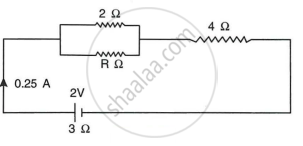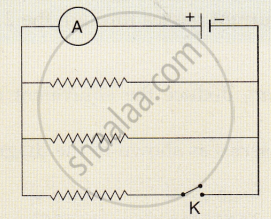Advertisements
Advertisements
प्रश्न
The circuit diagram Fig shows three resistors 2 Ω, 4 Ω and R Ω connected to a battery of e.m.f. 2 V and internal resistance 3 Ω. If main current of 0.25 A flows through the circuit, find:

- the p.d. across the 4 Ω resistor,
- the p.d. across the internal resistance of the cell,
- the p.d. across the R Ω or 2 Ω resistors
- the value of R.
उत्तर
Current I = 0.25 A = `1/4` A,
(i) Potential difference across the 4Ω resistor = current through the resistor × its resistance
= 0.25 × 4
= 1V
(ii) Potential difference across internal resistance= current through internal resistance × internal resistance
= 0.25 × 3
= 0.75V
(iii) P.d. across the R Ω or 3 Ω resistor= emf - (p.d. across 4Ω resistor + p.d. across internal resistance)
= 2 - (1 + 0.75)
= 0.25V
(iv) We know, e = I `[("r" + 4 Ω) + (1/2 + 1/"R")^-1]`
2 = 0.25 `[7 + (2"R"/"R" + 2)]`
or, `(2"R")/("R" + 2) = 1`
or 2R = R + 2
or R = 2 Ω
APPEARS IN
संबंधित प्रश्न
Differentiate between resistances in series and parallel.
Complete the following :-
(b)

In the diagram shown below, the cell and the ammeter both have negligible resistance. The resistor are identical.
How will you connect three resistors of 2 Ω, 3 Ω and 5 Ω respectively so as to obtain a resultant of 2.5 Ω? Draw the diagram to show the arrangement.
You have three resistors of values 2Ω, 3Ω and 5Ω. How will you join them so that the total resistance is less than 1Ω? Draw diagram and find the total resistance.
Calculate the equivalent resistance between the points A and B in Fig. if each resistance is 2·0 Ω.

A combination consists of three resistors in series. Four similar sets are connected in parallel. If the resistance of each resistor is 2 ohm, find the resistance of the combination.
An electrical appliance having a resistance of 200 Ω is operated at 200 V. Calculate the energy consumed by the appliance in 5 minutes in kWh.
Two resistors having resistance 8 Ω and 12 Ω are connected in parallel. Find their equivalent resistance.
